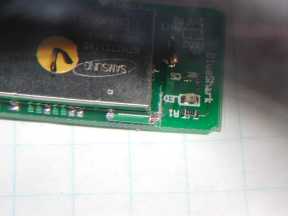
Blue tooth project
I have a pair of class1 bluetooth USB data transfer units (I import them) they have a power output of around +20dBm (class 1) .They quote a data transfer rate of 750Kbs -1 Mb/s so they would be ok for net surfing and even some data transfer . You are supposed to be able to have a small network of up to seven bluetooth units at one time! The receive sensitivity is quoted at around -80 dBm. They quote an operative range of about 100m and given the size of the units themselves and the antenna configuration inside, I guess this is not too bad all things considered .
BUT what if we decided to use some decent antennas on them ? The beauty of the USB version is that they can be placed at the antenna and thus minimise feeder loss .The units are powered by way of the USB cable and although you are not supposed to run USB cables over 5m with a ver 1.1 USB, you can get away with quite a lot longer cables before things turn to custard, a run maybe up to 10-12 meters! However, if you use a proprietary USB inline booster ( data repeater) then you can go much further ! up to 30m ( ie mount your unit much higher up the pole to get even better performance.) I dismantled the USB " dongle" to see what is inside and was amazed to see how small the whole FHSS transceiver actually is . It is hidden under some shielding . I found the 2.4 GHz folded antenna and where it was soldered to the double sided PC board. There was a small printed circuit track (50 ohms ???) that ran from the module to the antenna . I cut the track where the ground plane ceased ( antenna starts) and connected a small length of 50 ohm teflon coax with as short a connection as possible

50 ohm feed to pc board antenna to your left of upside R1
and ran this to an "n" connector at the end of a small plastic enclosure ( the more I think of it ,perhaps a metal enclosure for good RF screening would have been a better bet.)
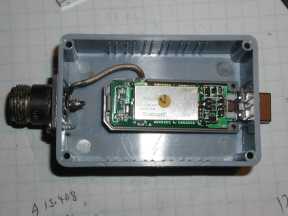
The free space path loss Lp, equation is more usefully expressed logarithmically:
Lp = 32.4 + 20 log "f" +20 log "d "
in db
where f is in MHz and d is Km
The good thing about this equation is that if we work in dB we can simply add and subtract to generate the answers, so long as we end up with a minimum signal of -80 dBm at the input to the receiver then it should work ( that statement allows no margin for signal fades!!)
I mounted the Bluetooth units on a 19 dB parabolic antenna complete with mounting hardware .
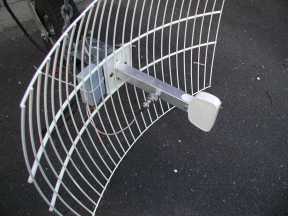
The usb cable ran to the pc and had the appropriate proprietary software installed Just for interest I monitored the bluetooth RF signal at 2,4GHz with the spectrum analyser while the Bluetooth module in the back of the laptop searched for other bluetooth devices. Below is the resulting screen dump, This is what Frequency Hopping spreadspectrum looks like ! looks like the bluetooth spectrum has had some teeth knocked out !! but you can see it occupies almost 100MHz of spectrum while it hops around.
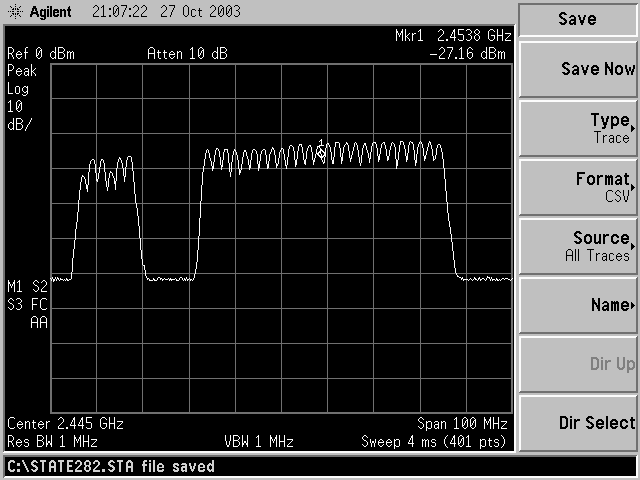
and this is what a DSSS signal from an 802.11b wireless Lan on the same band looks like !
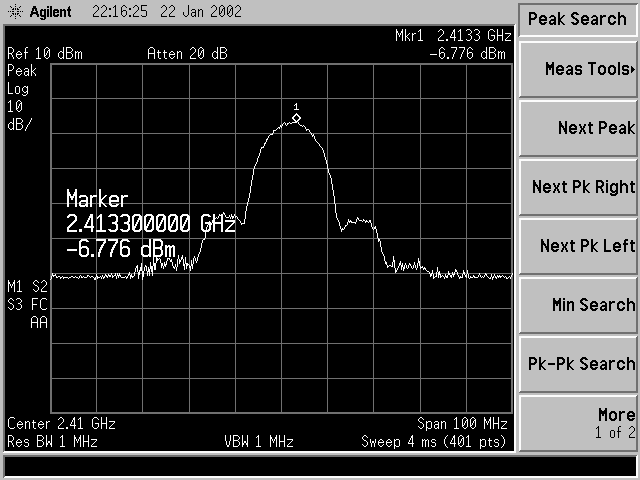
Both completely different and totally incompatible ! and to start a real argument, which mode is the better FHSS or DSSS ? I wont even go there!
Radio Range:
The rule of thumb is to double the range requires an increase of 6 db system gain . the manufacturer quotes a useable range of 100m between these two units . We hang a pair of 19 dbi antennas on them and that boosts the system gain by 38db ! 6 into 38 goes 6 times so we can expect at least a minimum range of :
100m *2(6db) =200m * 2( another 6db) =400m *2 (6db)=800m *2(6db)=1600m *2(another 6db) =3200m *2 (yes another 6db ( a total of 36 db and 2 db left))=6400m a respectable distance !
however if you plug the manufacturer RF performance figures into a range equation see: http://www.swisswireless.org/wlan_calc_en.html and http://www.ydi.com/calculation/index.php (there are heaps available on various commercial wireless Lan websites on the net ) 100mW rf out at 2,4 GHZ and a receive sensitivity of -81 dbm, you end up with an unobstructed range of 16 Km with a fade margin of almost 8 db !!!! you really must read this article http://www.tapr.org/tapr/html/ve3jf.dcc97/ve3jf.dcc97.html it is an excellent article on the nature of radio waves and propagation at uhf/shf it has so much useful information !
Make sure you have the encryption turned on in your bluetooth devices! you never know whose in your RF path ... could be embarrassing for some one,,,,,,, or the start of a beautiful friendship!
Have fun stretch the boundaries and never let your soldering iron cool down!